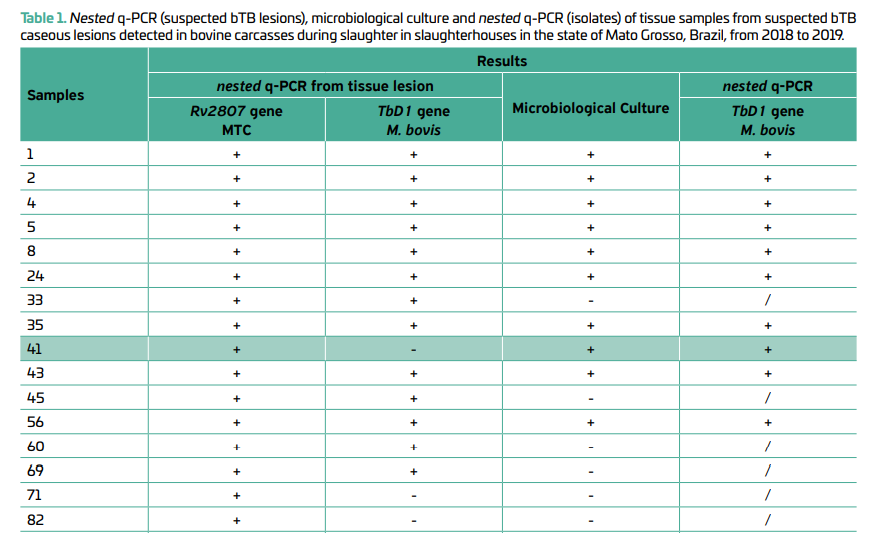The Rv2807 target gene: a determining factor to directly detect Mycobacterium bovis from suspected bovine tuberculosis lesions
DOI:
https://doi.org/10.21708/avb.2022.16.4.10988Resumo
Bovine tuberculosis (bTB) is a zoonosis caused by Mycobacterium bovis, a species belonging to the Mycobacterium tuberculosis complex (MTC) group. Direct bTB diagnosis from suggestive lesions can be performed by nested q-PCR targeting the Rv2807 gene present in the MTC group, as well as the TbD1 gene, present in M. bovis. In this context, the aim of the present study was to assess the importance of considering positive MTC results for the Rv2807 target gene obtained through the nested real time polymerase chain reaction (nested q-PCR) applied to samples obtained directly from suspected bTB lesions. A total of 174 samples of suggestive bTB caseous lesions were obtained during cattle slaughter in slaughterhouses in the state of Mato Grosso, Brazil. DNA was extracted from the lesions and nested q-PCR was performed to detect both MTC and M. bovis. Both samples positive for the Rv2807 (41/174) and TbD1 (29/174) were submitted to bacterial culturing (23/41), and the DNA of the isolates (23) was extracted and submitted again to nested q-PCR. The Rv2807 gene (MTC) was previously amplified by nested q-PCR directly from the lesions, although the TbD1 gene specific for M. bovis was not amplified previously in four of the successfully isolated samples (4/23), only following isolation, and only the Rv2807 gene was amplified before and after isolation. In conclusion, the target gene Rv2807 (MTC) exhibited higher positivity in the analyzed samples compared to the TbD1 gene (M. bovis).
Downloads

Downloads
Publicado
Edição
Seção
Licença
Copyright (c) 2022 Acta Veterinaria Brasilica

Este trabalho está licenciado sob uma licença Creative Commons Attribution 4.0 International License.
Autores que publicam na Acta Veterinaria Brasilica concordam com os seguintes termos: a) Autores mantém os direitos autorais e concedem à revista o direito de primeira publicação, com o trabalho simultaneamente licenciado sob a Licença Creative Commons Attribution que permite o compartilhamento do trabalho com reconhecimento da autoria e publicação inicial nesta revista. b) Autores têm autorização para assumir contratos adicionais separadamente, para distribuição não-exclusiva da versão do trabalho publicada nesta revista (ex.: publicar em repositório institucional ou como capítulo de livro), com reconhecimento de autoria e publicação inicial nesta revista. c) Autores têm permissão e são estimulados a publicar e distribuir seu trabalho online (ex.: em repositórios institucionais ou na sua página pessoal) a qualquer ponto antes ou durante o processo editorial, já que isso pode gerar alterações produtivas, bem como aumentar o impacto e a citação do trabalho publicado (Veja O Efeito do Acesso Livre).


 Esta obra está licenciada com uma Licença
Esta obra está licenciada com uma Licença 